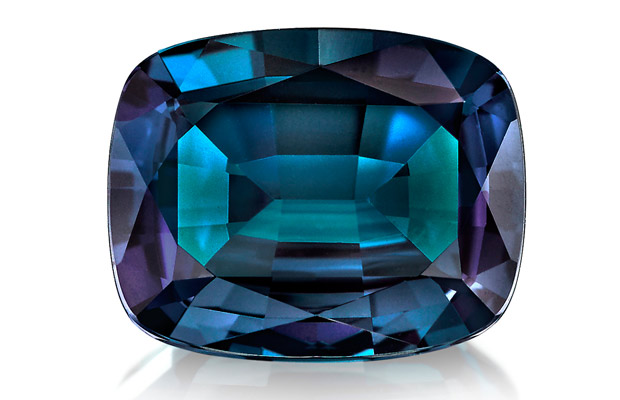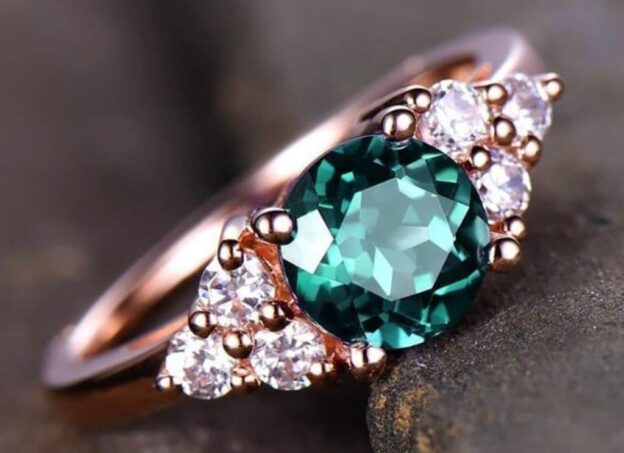Horoscope
According to astrologers, Alexandrite is most suitable for Gemini, Pisces and Scorpio. Aries can also wear it. But Taurus, Sagittarius, Cancer and Virgo should treat alexandrite with caution.
Alexandrite – a widow’s stone?
Despite the fact that alexandrite was discovered relatively recently and is still very young, there are already several legends and beliefs about it. In Russia, for example, it is believed that alexandrite is a widow’s stone. However, it can only be harmful if you wear one stone. The negative effect of alexandrite disappears if you wear two, or even better – three or four stones.
Alexandrite is loved all over the world
In Europe, this stone was considered a symbol of amorousness and at the same time – jealousy, which was facilitated by a change in color – from calm green to red, the color of rage. In Sri Lanka, where alexandrite is mined, it is considered a stone of longevity and prosperity. This is one of the favorite stones of the clergy. During the hours of prayer and meditation, he pacifies the soul.
In Indian astrology, alexandrite is characterized as a stone with a strong energy that reacts with a change in color to a change in the mood of the wearer.
It is suitable only for people who are strong in spirit and born under the sign of Scorpio. They must be ready to overcome adversity and all kinds of trials, then victory and luck await them. The Avestan school of astrology, on the contrary, believes that alexandrite tests a person for strength, giving him all kinds of difficulties. Among avid gamblers and gamblers, alexandrite is considered a talisman that ensures a win.
This stone is called the magic barometer, which shows the color change of the state, possible in the near future. For example, the appearance of yellow in it is a harbinger of an ordeal for the owner. Alexandrite is also considered the stone of travellers. It helps to adapt to a new environment, to understand a different way of life, to find a common language with anyone. If a person wears alexandrite, foreign languages are easier for him.
Healing properties
It has long been believed that the two colors of the alexandrite are magically associated with two circles of blood circulation in the human body. Therefore, for medicinal purposes, alexandrite is used mainly in connection with blood diseases. So, it was believed that alexandrite not only strengthens blood vessels but also cleanses the blood or stops bleeding that has arisen.
Lithotherapists believe that while wearing alexandrite, you need to monitor how often it changes color – constant color changes may indicate a sharp change in blood sugar levels. Before going to bed, alexandrite should be removed.
The history of alexandrite: two centuries or four millennia?
Finding Nordenskjold
Alexandrite was discovered by the Finnish mineralogist N. Nordenskjold. Exploring the Ural emerald mines, the scientist found a small green stone and took it with him in order to examine it in more detail under a magnifying glass. In the evening, holding the nugget to a candle flame, the mineralogist discovered that its color from emerald green to blood red.
Nordenskjold immediately reported the strange find to St. Petersburg. The properties of the stone, including the extraordinary hardness and ability to color reversal, were first studied by the jeweler Perovsky. He already wanted to give the mineral the name “diaphanite”, which in Greek means “seeming double”, but on that day, April 17, 1834, Russia celebrated the 16th anniversary of the son of Emperor Nicholas II Alexander. Wanting to please the ruling dynasty, Perovsky presented the nugget as a gift to the young Tsarevich, naming the stone in his honor alexandrite.
From the darkness of the ages
In fact, alexandrites were known long before the 19th century. The first mentions of a stone, shining and iridescent like a peacock’s eye, are found in the ancient Indian treatise “Mahabharata”, which is more than four millennia old. During excavations in Zaporozhye, archaeologists discovered the burial of the Polovtsian Khan of the 12th century, it was alexandrite that adorned his ring. The problem is that before Perovsky, no one could determine the nature of the mineral. The first detailed gemological description of the stone dates back to 1842.
Superstitions and legends of alexandrite
The gem immediately became fashionable among the Russian elite of that time. It was considered prestigious to wear jewelry with alexandrite, because these stones were not only expensive, but also rare. Only representatives of the upper classes, close to the court of the emperor, could afford them. The scanty choice of jewelry with alexandrite was partly due to, among other things, one omen – among the miners it was customary that if you find this nugget, then you will not see emeralds. So the hard workers tried not to pay attention to the alexandrites, and even more so not to raise them from the ground.
After the death of Alexander II, the popularity of the gem began to wane. However, be that as it may, the consequences of the fashion trends of the century before last are felt even now. Finding jewelry with genuine alexandrite is not an easy task. The reserves of the Ural mineral were completely depleted, and today it is easier to buy an artificial crystal with a color reverse effect than to find a natural one.
According to legend, the stone acquired the ability to change color after witnessing the crime of Cain. As if, since biblical times, a green crystal during the day has been filled with the blood of innocent Abel every evening, who has become a victim of fratricide.
Alexandrite: interesting features and facts
The largest gem-quality alexandrite was found in the Ural mines. The weight of the nugget was 532 carats, the price was more than 25 thousand rubles. There was no buyer who could give such an amount for the jewel, and the stone was divided into several pieces. For comparison: the annual salary in the first half of the nineteenth century. did not exceed 500 rubles.
The largest alexandrite weighing 1,876 carats (375.3 g) was found in Sri Lanka, and the largest of the faceted stones weighs 66 carats (13.2 g).
Residents of the former USSR are sure that all the jewellery purchased in Soviet stores is natural. However, few people know that for the entire period of the existence of the Soviet Union, not a single real alexandrite was sold through the official jewellery network. The fact is that the mineral was considered state property and was never sold for free. Thus, the only thing that guarantees the purchase of a product with alexandrite in the Soviet era is its synthetic origin.
In people, alexandrite is usually called a widow’s stone. It is believed that it can only be worn as a pair. The emergence of this sign has real historical prerequisites. The revival of the fashion for jewellery with alexandrite happened in the post-war period. Many women who lost their husbands on the battlefield wore rings and earrings with artificial alexandrite. So, there was a warning that the stone brings grief to the family. But it really has nothing to do with genuine jewellery.


